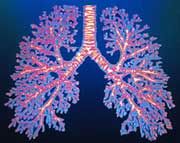Radiation zaps bystanders

Radon causes about 17,000 cases of lung cancer in the US each year. <br>© SPL <br>
Radon may pose a greater cancer threat than has been thought.
Radon damage from irradiated cells spreads to their neighbours, a new study finds1. The result suggests that small amounts of this radioactive gas could cause widespread harm.
The study “is a reason for concern but not panic”, says Gerhard Randers-Pehrson of Columbia University, New York, a member of the team that performed the study. “We’re talking about the acceptable level of radon changing perhaps by a factor of two, not 100.”
Even this change could mean many more houses currently on the borderline of acceptable limits needing attention. Decaying uranium in granite rocks and soil releases radon.
Where there is a lot of granite, such as in the US Appalachian region, radon dissolved in water can seep through cracks in basement floors to produce potentially dangerous concentrations in homes. Ventilation and filling cracks in basement floors and walls can cut radon levels.
The results so far are for cells in culture. Radon exposure might not have the same effect on bodies, cautions Barry Michael of the Gray Cancer Institute in London. “The mix of cell types in living organisms might lead to a very different picture,” he says.
Radon causes about 17,000 lung cancer cases in the United States each year, according to the US National Cancer Institute. Radioactive particles emitted by inhaled radon break DNA in cells, causing mutations that can lead to cancer.
Most estimates of the risk from low-level radon exposure are made by measuring cancer in people exposed to high radon levels, such as uranium mineworkers. Experts tend to assume that a person who receives half as much radiation as another, for example, has half the risk.
But irradiating just 10% of the cells in a culture resulted in nearly as many mutations irradiating them all, the Columbia found. Many cells not directly hit showed mutations, suggesting that simple extrapolation may underestimate the risk of a low dose of radon.
“It seems that when a cell is irradiated, it sends a signal to neighbour cells that causes them to get damaged too,” says Randers-Peterson. “We don’t know why this happens.”
Michael’s studies, on the other hand, have found that neighbouring cells cause irradiated cells to age, so that they die before becoming cancerous. “We need more research to understand the balance between damaging and protective impacts of low-dose irradiation,” he says.
Further study is needed, agrees Randers-Pehrson. But he thinks that health experts should take note of his findings. “The reason we were doing this experiment was to help decide what kind of level is dangerous,” he says.
References
- Zhou, H. et al. Radiation risk to low fluences of alpha particles may be greater than we thought. Proceedings of the National Academy of Sciences, 98, 14410 – 14415, (2001).
Media Contact
More Information:
http://www.nature.com/nsu/011206/011206-7.htmlAll latest news from the category: Health and Medicine
This subject area encompasses research and studies in the field of human medicine.
Among the wide-ranging list of topics covered here are anesthesiology, anatomy, surgery, human genetics, hygiene and environmental medicine, internal medicine, neurology, pharmacology, physiology, urology and dental medicine.
Newest articles
Faster, more energy-efficient way to manufacture an industrially important chemical
Zirconium combined with silicon nitride enhances the conversion of propane — present in natural gas — needed to create in-demand plastic, polypropylene. Polypropylene is a common type of plastic found…

Energy planning in Ghana as a role model for the world
Improving the resilience of energy systems in the Global South. What criteria should we use to better plan for resilient energy systems? How do socio-economic, technical and climate change related…

Artificial blood vessels could improve heart bypass outcomes
Artificial blood vessels could improve heart bypass outcomes. 3D-printed blood vessels, which closely mimic the properties of human veins, could transform the treatment of cardiovascular diseases. Strong, flexible, gel-like tubes…





















